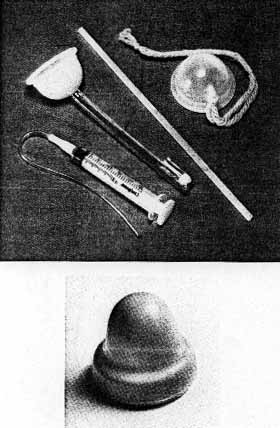
BY ELIZABETH NOBLE, HOUGHTON MIFFLIN, BOSTON; 1987.
My wife and I are the family litmus papers. My cousin tries things
out on us first. If we don't turn pink, she can tell the rest of
the family. She told me first that she was gay. I had just survived a brief
encounter with Death, and had the survivor's aura of vulnerability that
confers a sense of trust. Next, she told us that her lover was converting
to Judaism, a prelude to their marriage, we supposed. So if it couldn't
be a nice Jewish boy...well, this would be all right, too. A couple of
years later, they came to announce their plans to have a baby. My cousin
would be the mother; that was settled. The question was: whence the sperm?
They had approached Beth's brother, but were puzzled at his reservations,
as well as our own. We could understand their wish to draw from the genetic
and cultural heritage of both families, but can an uncle be a father, too?
They were getting little help from the medical establishment; third-party-payers
do not ordinarily cover donor insemination for those who are not legally
married.
This book would have
been a help. Not that it has the answers—it raises far more questions than
it offers solutions. But, ah, such questions! The technical section
is surprisingly short for such a comprehensive text, and contains clear
and concise information on anatomy, physiology, legalities, and sperm banks.
There are a few pages on technique, from the obligatory turkey baster to
the more sophisticated use of the cervical cap, a small rubber or plastic
yarmulke
that holds the semen at the entrance to the uterus.
The rest of the book is a bible of moral, ethical and interpersonal
dilemmas. There is one commandment: cosnoscatur donator--let the
donor be known. It stems from the personal experience and conviction of
the author, who herself undertook donor insemination. Time and again,
she makes the point that dealing with an anonymous donor is a dehumanizing,
impersonal, and
(forgive me) sterile experience. She finds it inconceivable [I'm sorry,
I'm sorry] that a mother, her husband, the semen donor, and
the child would not want to know each other. Please note, O ye
in need of sensitization, that the term "artificial insemination,"
with its connotation of unnaturalness, is out, and "DI" is in. Elizabeth
Noble, director of the Maternal and Child Health Center in Cambridge, Massachusetts,
tells of her experiences in conceiving and raising her daughter, Julia.
She and her husband, who was infertile, ruled out her former lovers as
donors, refused the offers of friends who coyly offered an in vivo experience,
and settled on a friend in Canada. It is curious that Noble, with her emphasis
on openness of donor identity, refers to her husband as Geoff, her daughter
as Julia, and the donor as X. She describes a humorous assignation
in the bathroom of the friend's house. First, she was to leave the cervical
cap in the soap dish. He was then to dash to the bathroom to leave
his semen in the cervical cap. Next, she was to return to the bathroom
to insert the sperm-laden cap. Their efforts had to be tightly coordinated,
in order to avoid interruption by a bevy of teenage girls who were sleeping
over for a pajama party.
Noble was open-with her daughter about the identity of the donor from the start. At the age of four and a half, Julia announced that "the father gets the sperm from his penis and puts it in the mother's hand and then she puts it in her 'gina'." Ms. Noble believes that Julia has not just intrauterine memories, but a preconceptual conception of her own conception.
All right, out with it: I think Ms. Noble is a bit of a flake. But this does not detract from the glorious complexity of the questions that she raises and thoughtfully discusses in her book. Should the donor's identity be known? If a donor is not the "father" of the baby, then who is? In many jurisdictions, children born of DI must be legally adopted and legitimatized by their mother's husband. If a fertile husband donates his sperm to a surrogate mother for gestation, who is the father? Should the semen of donor and husband be mixed? Some feel that this enhances the sense of paternity of the husband, while in other jurisdictions, legal and canonical, the practice is outlawed.
You can't legislate morality. Or can you? O, King Solomon, where
are you, now that we need you?

Top: Plastic insemination cervical cups with frozen semen straw and
syringe (Courtesy of Milex Products, Inc.).
Bottom: Rubber contraceptive cervical cap (Courtesy of Lambert/Dalston.
Photograph by Artemis/Harriette Hartigan)